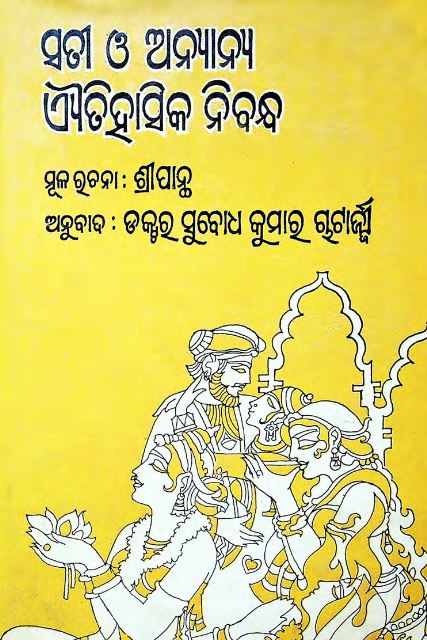Sati O Anyanya Aitihasika Nibandha by Sripanthin: A Treasure Chest of Odia Literature.Odia literature has been known to evoke the essence of Odisha’s culture, history, and heritage through its compelling narratives and impressive storytelling. Among the many gems of Odia literature, the book “Sati O Anyanya Aitihasika Nibandha” by Sripanthin stands out as a remarkable collection of historical essays. With its profound insights, meticulous research, and skillful narration, this book offers a treasure trove of knowledge about Odisha’s past.
“Sati O Anyanya Aitihasika Nibandha” is a book that delves deep into the history of Odisha, exploring various facets of the bygone era. Authored by Sripanthin, a distinguished scholar and historian, this book showcases his expertise in analyzing historical events and presenting them in a lucid yet captivating manner. With his extensive research and attention to detail, Sripanthin brings the past to life, making the readers truly immerse themselves in the historical context.
The book begins by discussing the practice of ‘Sati,’ which was prevalent during certain periods of history. ‘Sati’ refers to the tradition where a widow would voluntarily self-immolate on her husband’s funeral pyre. Sripanthin examines the origins, socio-cultural factors, and religious beliefs associated with Sati, providing a comprehensive understanding of this practice. He explores how Sati was being used as a tool of control over women and sheds light on the various attempts made by social reformers and colonial rulers to eradicate this practice.
Apart from focusing on Sati, the book also covers a wide range of other historical topics. Sripanthin delves into the rich legacy of Odia literature, highlighting the works of eminent writers such as Sarala Das, Upendra Bhanja, and Fakir Mohan Senapati. He portrays their contributions to Odia literature and provides valuable insights into the socio-political climate in which they created their masterpieces.
Furthermore, this book discusses several important historical events that shaped the course of Odisha’s history. Sripanthin elucidates the rise and fall of various dynasties, including the Kalinga dynasty and the Gajapati rule. He meticulously analyzes their political strategies, military conquests, and cultural patronage, giving readers a deep understanding of Odisha’s past.
One of the book’s unique aspects is Sripanthin’s ability to connect historical events to the present. He draws parallels between ancient Odisha and the modern state, highlighting the continuity of culture, traditions, and values. By doing so, he awakens a sense of pride and nostalgia among readers, fostering a deeper appreciation for Odisha’s rich heritage.
The language used in “Sati O Anyanya Aitihasika Nibandha” is fluid, eloquent, and quintessentially Odia. Sripanthin’s prose effortlessly transports readers to historical settings, making them feel like witnesses to the events he describes. His writing style strikes a perfect balance between academic rigor and engaging storytelling, ensuring that readers of all backgrounds can enjoy and benefit from this book.
In conclusion, “Sati O Anyanya Aitihasika Nibandha” by Sripanthin is undoubtedly a masterpiece of Odia literature. It not only chronicles the historical events of Odisha but also explores the socio-cultural nuances that shaped the state’s identity. Through his impeccable research and captivating storytelling, Sripanthin has created a literary work that will undoubtedly leave a lasting impact on anyone seeking to delve deeper into Odisha’s vibrant history.
Books Info
| Books name | Sati O Anyanya Aitihasika Nibandha /ସତୀ ଓ ଅନ୍ୟାନ ଐତିହାସିକ ନିବନ୍ଧ |
| Author | Sripanth |
| No Of pages | 193 |
| Publisher | Vidyapuri |
| Publication | 1992 |
| Printed At | NA |
| Distributor | NA |

